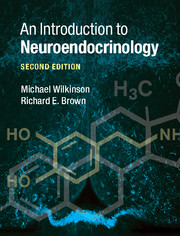Book contents
- Frontmatter
- Dedication
- Contents
- Preface to the second edition
- Acknowledgements
- List of abbreviations
- 1 Classification of chemical messengers
- 2 The endocrine glands and their hormones
- 3 The pituitary gland and its hormones
- 4 The hypothalamic hormones
- 5 Neurotransmitters
- 6 Neurotransmitter and neuropeptide control of hypothalamic, pituitary and other hormones
- 7 Regulation of hormone synthesis, storage, release, transport and deactivation
- 8 Regulation of hormone levels in the bloodstream
- 9 Steroid and thyroid hormone receptors
- 10 Receptors for peptide hormones, neuropeptides and neurotransmitters
- 11 Neuropeptides I: classification, synthesis and co-localization with classical neurotransmitters
- 12 Neuropeptides II: function
- 13 Cytokines and the interaction between the neuroendocrine and immune systems
- 14 Methods for the study of behavioral neuroendocrinology
- 15 An overview of behavioral neuroendocrinology: present, past and future
- Index
- References
13 - Cytokines and the interaction between the neuroendocrine and immune systems
Published online by Cambridge University Press: 05 June 2015
- Frontmatter
- Dedication
- Contents
- Preface to the second edition
- Acknowledgements
- List of abbreviations
- 1 Classification of chemical messengers
- 2 The endocrine glands and their hormones
- 3 The pituitary gland and its hormones
- 4 The hypothalamic hormones
- 5 Neurotransmitters
- 6 Neurotransmitter and neuropeptide control of hypothalamic, pituitary and other hormones
- 7 Regulation of hormone synthesis, storage, release, transport and deactivation
- 8 Regulation of hormone levels in the bloodstream
- 9 Steroid and thyroid hormone receptors
- 10 Receptors for peptide hormones, neuropeptides and neurotransmitters
- 11 Neuropeptides I: classification, synthesis and co-localization with classical neurotransmitters
- 12 Neuropeptides II: function
- 13 Cytokines and the interaction between the neuroendocrine and immune systems
- 14 Methods for the study of behavioral neuroendocrinology
- 15 An overview of behavioral neuroendocrinology: present, past and future
- Index
- References
Summary
Cytokines were introduced in Chapter 1 (section 1.4.9) as signaling molecules secreted by cells of the immune system. They are important components of the interconnected neural, endocrine and immune systems (see Figure 1.2). For example, various types of stress, including academic examinations, influence the immune system via an activation of the hypothalamic-pituitary-adrenal axis and the secretion of glucocorticoids (see Figures 6.1 and 6.4). Likewise, an immune response that stimulates white blood cells to produce cytokines, for example following an infection, has effects on the hypothalamic control of various hormones such as ACTH, GH and PRL. Since most immune cells have receptors for these hormones, the immune system is affected directly by pituitary hormones as well as by adrenal output of glucocorticoids or catecholamines (Figure 1.2). The immune system, therefore, via secretion of cytokines, participates in a classic neuroendocrine feedback system. There are also profound sex differences in immune responses and some of this variation is due to the effects of sex steroids, such as testosterone and estradiol. For example, 80 percent of patients with autoimmune diseases (e.g. rheumatoid arthritis; multiple sclerosis) are women; 60 percent of adult asthma cases are women; and men are at least 1.6-fold more likely than women to die from malignant cancers (Klein 2012).
This chapter begins with an overview of those cells of the immune system that secrete cytokines, and then discusses the immune functions of the thymus gland and its hormones. The roles of cytokines in the immune response to antigens (i.e. substances that cause an immune response) and in the development of blood cells are then summarized and the neuromodulatory effects of cytokines on the brain and neuroendocrine system are examined. This is followed by a discussion of the neural and endocrine regulation of the immune system and the hypothalamic integration of neural, endocrine and immune systems.
The cells of the immune system
The immune system consists of many different cell types, including several that secrete cytokines; i.e. monocytes, macrophages, T lymphocytes (T cells), B lymphocytes (B cells) and natural killer (NK) cells (see Figure 13.1).
- Type
- Chapter
- Information
- An Introduction to Neuroendocrinology , pp. 351 - 399Publisher: Cambridge University PressPrint publication year: 2015



